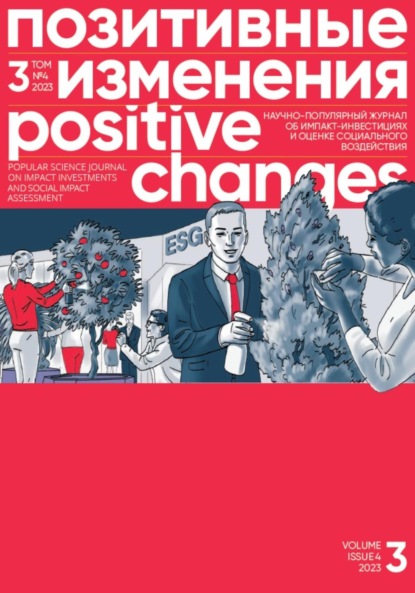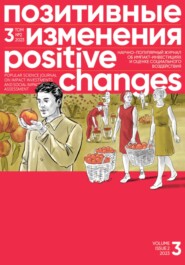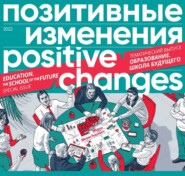По всем вопросам обращайтесь на: info@litportal.ru
(©) 2003-2024.
✖
Позитивные изменения. Том 3, № 4 (2023). Positive changes. Volume 3, Issue 4(2023)
Настройки чтения
Размер шрифта
Высота строк
Поля
Researchers also strive to calculate well-being losses and gains resulting from various factors and policies. Moreover, WALY enables the measurement of the Happiness Return on Investment (HROI).
According to Natalia Kosheleva, there is a significant development in the assessment of how projects impact individuals’ subjective well-being. For example, substantial work in this direction has been carried out in the United Kingdom. There is a center dedicated to evidence-based approaches in projects aimed at enhancing well-being. Since 2011, the annual population survey features four questions related to personal well-being. Respondents are asked to rate their current life satisfaction on a scale of 1 to 10, assess the significance of their life pursuits, reflect on their happiness the previous day, and indicate their level of anxiety during the same period.[21 - Office for National Statistics. Surveys using our four personal well-being questions. Retrieved from: https://www.ons.gov.uk/peoplepopulationandcommunity/wellbeing/methodologies/surveysusingthe4officefornationalstatisticspersonalwellbeingquestions. (accessed: 11.12.2023).]
Approaches to assessing the quality of life, well-being, and happiness are interlinked. They can be categorized into three groups, based by their impact scale.
In the UK, creative approaches to measuring well-being have also emerged. Convinced that the purpose of exhibitions includes influencing people’s emotional and psychological states, museums have particularly excelled in this area. To assess this impact, all visitors are invited to select a leaf of a specific color at the entrance to the exhibition and attach it to a tree. Following a color-coded system, a red leaf signifies “I feel good and prosperous,” a yellow leaf indicates a neutral state, and a green leaf expresses “I feel sad.” At the exit, visitors encounter another tree. Subsequently, the number of leaves of each color at the entrance and exit is tallied to gauge whether the exhibition has affected people’s emotional states.
RUSSIAN EXPERIENCE
Over the past three years, various indices for measuring happiness and well-being have also made their debut in Russia. The pioneer was the Russian Cities Quality of Life Index, developed in 2021 by VEB.RF in collaboration with PwC (now known as Trust Technologies) and the Russian Academy of National Economy and Public Administration, in partnership with the Agency for Strategic Initiatives (ASI). This comprises an information and analytical system that, as of 2023, consists of several components:[22 - VEB.RF (2023). Quality of Life Index. Retrieved from: https://citylifeindex.ru/. (accessed: 11.12.2023).]
• A database encompassing data on over 300 indicators for 218 cities across Russia. It allows analyzing and comparing cities, including with their foreign counterparts (based on individual indicators).
• City profiles, offering a detailed portrait of each city and facilitating comparisons of specific indicators with the national average or a cluster of similar cities.
The Timchenko Foundation also developed the General Index of Child Well-being, introduced in 2021, followed by the RUSAL Cities Quality of Life Index in 2022. These indices share a similar structure and rely on specific indicators. In the following sections, we will delve into each of these indices in more detail and explore how they can be utilized to assess conditions in various regions.
RUSAL’S CITIES QUALITY OF LIFE AND SUSTAINABLE DEVELOPMENT INDEX
This index, introduced in 2022, forms the basis of the company’s new social investment strategy. Irina Bakhtina, RUSAL’s Chief Sustainability Officer, explained that it is founded on criteria used by the Organization for Economic Cooperation and Development (OECD) as well as the VEB.RF Quality of Life Index.[23 - VEB.RF (2023). Quality of Life Index. Retrieved from: https://citylifeindex.ru/. (accessed: 11.12.2023).] The key distinction between RUSAL’s index and VEB.RF’s database lies in the population size of the territories under examination. RUSAL is interested in evaluating the quality of life and sustainability in cities and communities with populations of below 50,000.
66 indicators were considered in the development of this index, including statistical data (32 indicators), survey data (19 indicators), and information obtained through requests to regional and local authorities (15 indicators). RUSAL’s comprehensive tool covers 21 territories, including cities and municipal districts, across 12 dimensions of quality of life, categorized into three aspects: Values, Environment, and Potential.
“Values” include the following characteristics: 1) Work-life balance, leisure opportunities, and consumption of goods and services.
2) The ability to maintain regular contact with family and acquaintances, trust in the community, and a willingness to participate in social activities.
3) Satisfaction with life and confidence in the future.
4) Public safety.
“Environment” includes:
1) A comfortable, appealing, and diverse urban environment, encompassing streets, parks, and public spaces.
2) Good health and access to advanced medical care.
3) Favorable environmental conditions and an advanced waste management system within the city.
4) Availability of high-quality, well-maintained, and conveniently located housing.
The Happiness Research Institute suggests a unit of measurement known as WALY – life years adjusted based on the subjective level of well-being.
“Potential” comprises the following characteristics:
1) Access to employment opportunities that enable income and professional growth.
2) Extensive opportunities for receiving quality education for both children and adults.
3) Convenient transportation within the city and the ability to travel beyond its borders.
4) Effective governance and protection of civil rights.
“We consistently emphasize: this is not a ranking; it’s a diagnostic tool. It is crucial for us to identify areas where we may be falling short and to understand why. It is essential to examine the results in a comparative context. Why is this important? If our employees and their families move from one plant to another, we want to assess how their quality of life might change,” explains Irina Bakhtina.
Based on the results of 2022, regional centers such as Volgograd, Krasnoyarsk, Sayanogorsk, Novokuznetsk, along with the Sharypovsky district of the Krasnoyarsk Krai and Kandalaksha in the Murmansk region, took the lead in the index rankings. Conversely, the territories of the Irkutsk region lagged behind. For instance, Taishet, a city in the Irkutsk region with a population of 34,000, occupied the 21st position out of 21 in terms of socio-economic well-being. Respondents provided a low subjective rating of urban improvement quality, highlighted inadequate street lighting, noted low participation of children in extracurricular activities, reported low scores in the Unified State Exam (USE), mentioned a scarcity of events and cultural institutions in the city, pointed out a high accident rate, and cited limited affordability of housing.
Understanding the landscape of these issues serves as a crucial reference point for making decisions regarding social investments. In this regard, the company hopes that by addressing significant problems in Taishet and other cities and regions, it will witness improvements reflected in the index in the years to come.
CHILD WELL-BEING INDEX
The Child Well-Being Index serves as a data source to gauge the quality of life for children. Such indices are employed in numerous countries across the world. For instance, there is a report from Ireland’s Department of Children’s Affairs on the state of the child sector in the country, the Child Poverty and Hardship Index in the Kyrgyz Republic, the National Cohort Study and School Health Surveys in Finland, and Kazakhstan’s Child Wellbeing Index.
In Russia, the Child Well-Being Index[24 - The Timchenko Foundation. (2022). About the Child Well-Being Index. Retrieved from: https://cwb-index.timchenkofoundation.org/about/. (accessed: 11.12.2023).] was developed with contributions by the Timchenko Foundation, the Russian Academy of National Economy and Public Administration, Lomonosov Moscow State University, Moscow State University of Psychology and Education, National Research University Higher School of Economics, the Public Chamber of the Russian Federation, and the Russian Ministry of Education.
This instrument consists of two indices: the Statistical Index of Child Well-Being, calculated based on 27 indicators published by Rosstat, and the Subjective Index of Child Well-Being, derived from 18 indicators obtained through surveys of children and their parents.
The Statistical Index encompasses four domains: health, development, material well-being, and security. Meanwhile, the Subjective Index includes six domains: health, material well-being, safety, education, social relationships, and self-actualization. The data collection system for the Subjective Index is designed to allow measurement not only at a regional level but also at the level of specific schools. Within each domain, responses to three questions are analyzed. For example, in the “Material Well-Being” domain, these questions pertain to assessing the family’s financial situation, whether the child has personal belongings and whether the child has been on vacation.
The creators of the index emphasize the importance of separately measuring the statistical and subjective indices of child well-being, with special attention given to situations where children’s assessments fall below the statistical figures.
“Of course, for us, the priority is not just the numbers that compile the ranking. As a foundation, our primary concern is the well-being of the child. In other words, how the data from such a comprehensive study influences management decision-making based on an evidence-based approach,” explains Elina Illarionova, Head of the Analytical Service at the Timchenko Foundation.
It is important to separate measuring the statistical and subjective index of child well-being, with attention given to situations where children’s assessments fall below the statistical figures.
According to the Russian Child Well-Being Index for 2022, families with children are facing financial challenges, with only 50 % of surveyed children rating their family’s financial situation positively. Additionally, there is room for improvement in children’s access to leisure activities, as 55 % of surveyed children had not traveled anywhere in the past year. Children’s self-esteem is relatively low, with only 45 % of them reporting achievements and successes they take pride in. Furthermore, there is potential to enhance children’s motivation and interest in learning, as 70 % of the surveyed children expressed liking school, and 65 % found their lessons interesting.
These findings can serve as the foundation for practical initiatives. For example, in Altai Krai, day care groups were established for children from families facing financial difficulties, allowing parents the freedom to work or pursue further education, thereby increasing the family’s income. In Nizhnevartovsk, libraries have created spaces for children and teenagers to explore their interests. In Langepas, summer camps and evening leisure activities were organized, enabling children to discover new talents and interests. In the Tambov region, efforts are being made to boost children’s interest in learning through the expansion of Olympiad programs and the introduction of new supplementary education programs in various fields: arts, natural science, technology, tourism and local lore, social science and pedagogy, physical education and sports.
According to Elina Illarionova, the developers of the index collaborate with regional analytical groups, often based at universities, which can provide practical recommendations to specialized agencies. Both the Subjective and Statistical Indices of Child Well-Being are publicly accessible and can benefit a wide range of stakeholders, including regional and federal authorities, NGOs, social investors, the expert and scientific community, as well as parents and children.
“We strive to ensure that the index data is integrated into regulatory frameworks to lay the groundwork for child welfare programs. On top of that, we believe that presenting the research results should involve the active participation of children, and that the data should not only inform management decisions but also justify the need for child-centric policies,” emphasizes Elina Illarionova.
WHAT POSITIVE PSYCHOLOGY CAN OFFER AS A FIELD OF SCIENTIFIC KNOWLEDGE
How does an individual’s perception of happiness and well-being relate to themselves? Are external circumstances in which a person lives influencing this perception? Why is it essential to incorporate subjective and psychological well-being into our evaluations? Answers to these questions can be found by delving into the realm of positive psychology.
When we mention “positive psychology,” most often, it conjures associations with affirmations, a positive mindset, and optimistic thinking. In other words, “think positively, and everything will be fine.” However, this is not the complete picture. Positive psychology, as a distinct branch of psychological knowledge and practice, explores the resources within individuals, their satisfaction, values, talents, and their connection to happiness. These discussions were also part of the Wellbeing-Focused Evaluation track.
The concept of subjective well-being emerged in psychology during the 1970s when the age-old philosophical question of happiness became a focal point for empirical investigation within this field, as explained by Anna Hegai, a graduate student and teacher at the Higher School of Economics, and a psychologist-methodologist at the Victoria Charitable Children’s Foundation.
Researchers identify three approaches to measuring well-being:
1. Subjective well-being (E. Diener) – how closely a person believes their life aligns with the most desirable state.
2. Psychological well-being (C. Ryff, D. Leontiev) – the assessment of personality traits that contribute to happiness (positive relationships with others, self-acceptance, having a life purpose, etc.).
3. Quality of life – an objective evaluation of the favorability of external living conditions.














